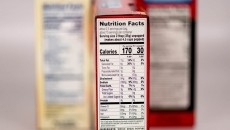Industry questions basis of FDA’s proposed caps for lead in baby food, seeks compliance guidance

In comments submitted earlier this month to FDA about draft guidance proposed in January for action levels for lead in food intended for babies and young children, stakeholders also ask the agency to clarify the scope of application of the proposed action levels and in some cases expand coverage to be more specific and include products that currently are not covered by the guidance.
In January, FDA proposed the draft guidance Action Levels for Lead in Food Intended for Babies and Young Children as part of its Closer to Zero Initiative launched in 2021, which includes establishing action levels for toxic elements in food intended for young children based on evolving science on health impacts and mitigation techniques and impact on industry achievability. The guidance follows a Congressional report released in early 2021 that alleged ‘dangerous’ levels of heavy metals in top baby food brands, and which triggered a torrent of lawsuits – which industry hopes to stem, or at least not fuel, by clarifying which products are covered by FDA’s draft proposed guidance.
Stakeholders view guidance as good first step, but far from perfect
Given the vulnerability of children under the age of two to the ill effects on their development of heavy metals in their diet, the Consumer Brands Association, FM – The Industry Trade Group, the American Academy of Pediatrics and others all lauded FDA’s draft guidance as a balanced approach to reducing young children’s exposure to heavy metals through food while also recognizing the fragility of the supply chain and the limits of manufacturers’ ability to fully avoid toxic elements that are prevalent at some level in the food supply.
“We applaud the work the US Food and Drug Administration (FDA) is doing under its Closer to Zero Action Plan for Reducing Childhood Exposure to Contaminants from Foods, which is science and risk-based and rooted in the ability of industry to achieve them or achievability. … We also agree with the FDA’s position that action levels of zero for heavy metals in foods are not practical nor achievable and, in fact, could have unintended consequences o eliminating certain nutrient dense foods from the marketplace and negatively impacting consumer dietary patterns,” the Consumer Brands Association said in comments submitted March 27 to Docket No. FDA-2022-D-0278.
The Center for Science in the Public Interest echoed this sentiment in comments submitted the same day, arguing: “as there are currently no standards for lead in children’s foods, we applaud the fact that the FDA has drafted action levels for lead of 10 ppb for fruits, vegetables, mixtures, yogurts, custards/puddings, and single-ingredient meats and 20 ppg for single-ingredient root vegetables and dry infant cereals.”
However, both groups along with many others, expressed concerns about the manner in which these action levels were derived – although they come at it from different angles.
CSPI wants guidance based on public protection rather than achievability
CSPI said it finds “the lack of detail in the draft guidance lowers our confidence that these proposed action levels are the most protective action levels the agency could proposed.”
It explains that while it is “encouraged” to see the guidance focused on “exposure, rather than achievability,” it complained “due to a lack of detail … it is unclear what the quantitative exposure benchmarks of success were and whether those benchmarks were directly used as the foundation for the proposed action levels or lead in foods intended or children.”
It added: “We are concerned that these action levels were arbitrarily derived and given undue deference to achievability.”
As such, CSPI asks FDA “further revise its approach to better ground the Closer to Zero action plan in public health protection.”
Industry groups argue achievability, supply chains must be considered
FMI counters that the final benchmarks must balance industry achievability and account for “potentially disruptive market impacts across the broader food supply chain.”
In comments submitted March 27, FMI argues, “as a threshold matter, action levels that are not commercially achievable may limit product choice for parents of babies and young children under two.”
To help ameliorate this threat, FMI and CBA urge FDA to consider additional factors when determining achievability.
These include the regional differences in growing conditions, differences in bioavailability and plant biology, and the impact of processing on concentration of heavy metals in finished products, FMI and CBA argue.
Both note that levels of lead and other heavy metals in the environment differ by geographic region, and CBA encourages FDA to consider the Global Environmental Monitoring System (GEMS)/Food Contamination Monitoring and Assessment Program for insights on levels and trends of contaminants in food, their contribution to total human exposure and how this might impact supply chains and achievability.
CBA also notes that “certain heavy metals may be less metabolically available based on the food matrix in which they occur. For example, the agency has proposed the same action levels for lead in most vegetables and all fruits marketed for babies and young children as for apple juice without addressing the fact that the bioavailability of heavy metals in solid foods and liquids can be quite different.”
The trade group says it also worries that grouping all produce into one category when establishing action levels may not be the best practice given variations in plant biology and soil regionally.
Finally, CBA notes, heavy metals and contaminants can concentrate in fruit and vegetable-based products that are partially or fully dried/dehydrated, as in teethers and puffs, upwards of six or seven times than that of non-dehydrated products. As such, it says, FDA should consider how processing impacts finished products when establishing action levels for heavy metals.
Compliance guidance needed
While clarifying the data sets used for establishing limits and impact of other factors would go a long way in helping industry comply with the guidance, trade groups also seek clarity on how FDA will assess compliance.
“During the recent FDA webinar on the draft guidance, the agency stated it would assess whether the industry is meeting the established action levels through continued sampling and testing and during facility inspections, specifically of those that make food marketed for babies and children under two,” CBA said.
It added it would also like ‘the agency [to] create instructions for the federal and state inspection forces, communicated through the Investigations Operations Manual (IOM), training manuals and/or by another appropriate means, outlining the approach to be used to determine if facilities that make foods marketed for babies and children under two are appropriately addressing heavy metals in their food safety and/or supplier management programs for those products.”
FMI called for FDA to identify and publish sample collection methods as well as analytical methos to help standardize and improve detection while also keeping an open mind about advances in analytical chemistry to be used as additional methods are validated.
FMI also encourages FDA “to provide substantially more guidance and best practice resources to assist the entire affected supply chain in mitigating and controlling led in the foods covered by the draft guidance and, by extension, the RACs and ingredients used to make them.”
Additional clarity about impacted products and a phase in period
While the guidance is intended for products for under the age of two years, trade groups note ambiguity in the draft guidance’s parameters could expose manufacturers to unnecessary litigation, a patchwork of state legislation and confuse consumers.
For example, FMI notes the background information in the draft guidance references “toxic elements” and the health impacts of lead on other populations and subpopulations not relevant to the target of the guidance.
It asks that to avoid confusion, FDA revise the discussion “to ensure all statements regarding the health impacts of lead focus directly on the subject and objectives of the final guidance.”
CBA also asks the agency to explicitly state that the term ‘young children’ in the guidance means children less than two years old, and it asks that the agency used the word ‘marketed’ instead of ‘intended’ through out the guidance to “emphasize that only foods specifically marketed for babies and young children under the age of two are subject to this guidance.”
It explains, “These two requested changes in combination would prevent confusion regarding whether certain foods marketed for all family or the general population need to meet the established action levels.”
Additional insights from stakeholders about the proposed draft guidance can be found in the comments submitted to the docket.

















